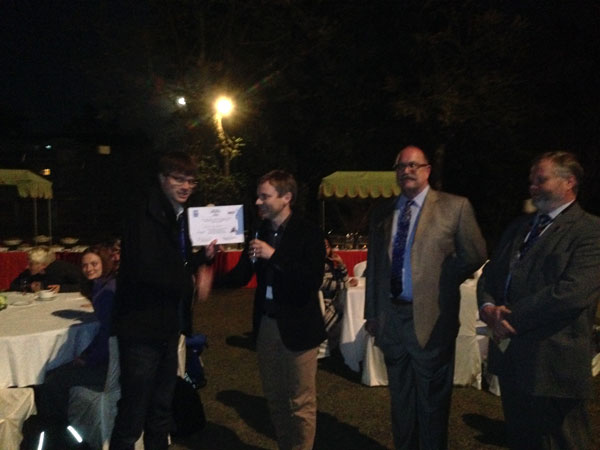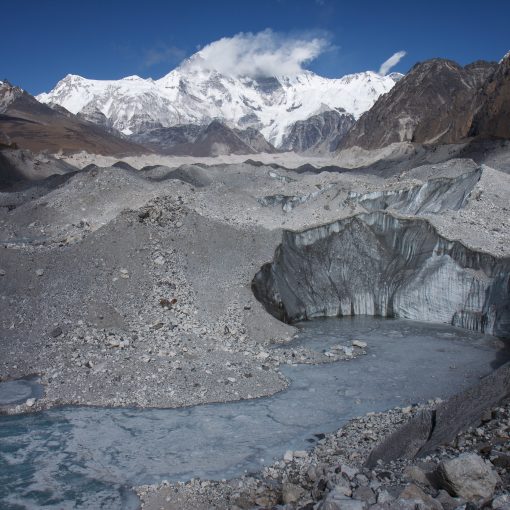The Annals of Glacioly issue with the theme ‘Glaciology in high-mountain Asia‘ will appear in 2016. A few articles of our research group in this issue are already available online as preprints or are accepted for publication.
Available online
- Seasonal surface velocities of a Himalayan glacier derived by automated correlation of unmanned aerial vehicle imagery
Philip KRAAIJENBRINK, Sander W. MEIJER, Joseph M. SHEA, Francesca PELLICCIOTTI, Steven M. DE JONG, Walter W. IMMERZEEL
[expand title=”Abstract“]
Debris-covered glaciers play an important role in the high-altitude water cycle in the Himalaya, yet their dynamics are poorly understood, partly because of the difficult fieldwork conditions. In this study we therefore deploy an unmanned aerial vehicle (UAV) three times (May 2013, October 2013 and May 2014) over the debris-covered Lirung Glacier in Nepal. The acquired data are processed into orthomosaics and elevation models by a Structure from Motion workflow, and seasonal surface velocity is derived using frequency cross-correlation. In order to obtain optimal surface velocity products, the effects of different input data and correlator configurations are evaluated, which reveals that the orthomosaic as input paired with moderate correlator settings provides the best results. The glacier has considerable spatial and seasonal differences in surface velocity, with maximum summer and winter velocities 6 and 2.5 m a–1, respectively, in the upper part of the tongue, while the lower part is nearly stagnant. It is hypothesized that the higher velocities during summer are caused by basal sliding due to increased lubrication of the bed. We conclude that UAVs have great potential to quantify seasonal and annual variations in flow and can help to further our understanding of debris-covered glaciers.
[/expand] - Refined energy-balance modelling of a supraglacial pond, Langtang Khola, Nepal
Evan S. MILES, Francesca PELLICCIOTTI, Ian C. WILLIS, Jakob F. STEINER, Pascal BURI, Neil S. ARNOLD
[expand title=”Abstract“]
Supraglacial ponds on debris-covered glaciers present a mechanism of atmosphere/glacier energy transfer that is poorly studied, and only conceptually included in mass-balance studies of Debris-covered glaciers. This research advances previous efforts to develop a model of mass and energy balance for supraglacial ponds by applying a free-convection approach to account for energy exchanges at the subaqueous bare-ice surfaces. We develop the model using field data from a pond on Lirung Glacier, Nepal, that was monitored during the 2013 and 2014 monsoon periods. Sensitivity testing is performed for several key parameters, and alternative melt algorithms are compared with the model. The pond acts as a significant recipient of energy for the glacier system, and actively participates in the glacier’s hydrologic system during the monsoon. Melt rates are 2–4 cm d–1 (total of 98.5 m3 over the study period) for bare ice in contact with the pond, and <1 mm d–1 (total of 10.6 m3) for the saturated debris zone. The majority of absorbed atmospheric energy leaves the pond system through englacial conduits, delivering sufficient energy to melt 2612m3 additional ice over the study period (38.4 m3 d–1). Such melting might be expected to lead to subsidence of the glacier surface. Supraglacial ponds efficiently convey atmospheric energy to the glacier’s interior and rapidly promote the downwasting process.
[/expand]
- A grid-based model of backwasting of supraglacial ice cliffs over debris-covered glaciers
Pascal BURI, Francesca PELLICCIOTTI, Jakob F. STEINER, Evan S. MILES, Walter W. IMMERZEEL
[expand title=”Abstract“]
Ice cliffs might be partly responsible for the high mass losses of debris-covered glaciers in the Hindu Kush–Karakoram–Himalaya region. The few existing models of cliff backwasting are pointscale models applied at few locations or assume cliffs to be planes with constant slope and aspect, a major simplification given the complex surfaces of most cliffs. We develop the first grid-based model of cliff backwasting for two cliffs on debris-covered Lirung Glacier, Nepal. The model includes an improved representation of shortwave and longwave radiation, and their interplay with the glacier topography. Shortwave radiation varies considerably across the two cliffs, mostly due to direct radiation. Diffuse radiation is the major shortwave component, as the direct component is strongly reduced by the cliffs’ aspect and slope through self-shading. Incoming longwave radiation is higher than the total incoming shortwave flux, due to radiation emitted by the surrounding terrain, which is 25% of the incoming flux. Melt is highly variable in space, suggesting that simple models provide inaccurate estimates of total melt volumes. Although only representing 0.09% of the glacier tongue area, the total melt at the two cliffs over the measurement period is 2313 and 8282 m3, 1.23% of the total melt simulated by a glacio-hydrological model for the glacier’s tongue.
[/expand]
Accepted
- Meteorological conditions, seasonal and annual mass balances of Chhota Shigri Glacier, western Himalaya, India
Mohd Farooq AZAM, Al. RAMANATHAN, Patrick WAGNON, Christian VINCENT, Anurag LINDA, Etienne BERTHIER, Parmanand SHARMA, Arindan MANDAL, Thupstan ANGCHUK, Virendra Bahadur SINGH, P.G. JOSE - Air temperature variability in a high-elevation Himalayan catchment
Martin HEYNEN, Evan MILES, Silvan RAGETTLI, Pascal BURI, Walter W. IMMERZEEL, Francesca PELLICCIOTTI - An assessment of basin-scale glaciological and hydrological sensitivities in the Hindu Kush–Himalaya
Joseph M. SHEA, Walter W. IMMERZEEL





